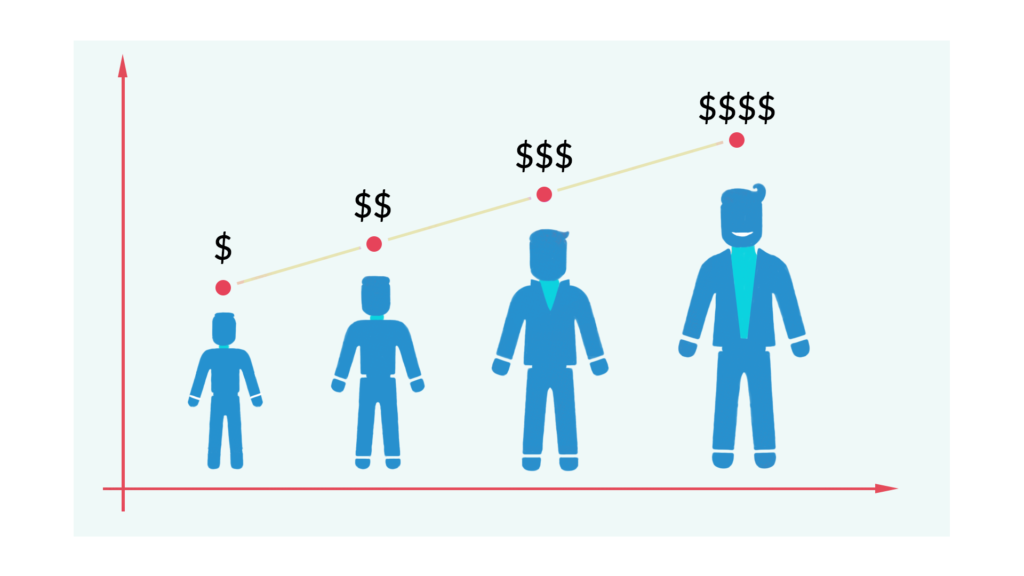
Lifetime Va… What Exactly is it?
LTV. Lifetime Value. We should be able to easily determine what it is and know what it can be used for. However, this is not as easy as it sounds. LTV is one of the most important metrics, often called the king of metrics. This is one of the pillars for creating and developing mobile games. Without it, the game would probably not be so well thought out, which could badly affect the return on investment (ROI). As you know, everyone would like to profit from their own work, and this indicator comes in handy here.
In the sections below, we will explain the Lifetime Value comprehensively, we will describe what it is used for, how to calculate it, we will list its pros and cons, and last but not least, we’ll tell you how to increase it.
However, let’s start from the very beginning. What is Lifetime Value?
LTV is the value that the product gains during its entire ’life’. However, it’s only the description. Let’s dig deeper.

Source: Neil Patel, How to Reinvent the Customer Experience to Increase Customer Lifetime Value
What is it Used For?
Imagine that you are a game developer and you have just finished your game. You have already implemented some ads, but you wonder how exactly to measure the value of your game. And more importantly, does it compare well to other games?
Let’s take a look at another case. You are looking for an investor or publisher who will be able to support you in User Acquisition and help monetise your game. However, you will not attract the publisher without showing them details and indicators. Very often publishers like Voodoo or Lion Studios require retention checks. If you show them Lifetime Value and it will be satisfactory, you will certainly have a better chance to succeed.
Next case: you already own a company and you want to plan your business strategy better, organise your UA and marketing department better. You know your game is addictive but the metrics somehow don’t work. The Lifetime Value is a great indicator because it consists of several other metrics, which is why it is so important to calculate LTV.
The above cases show that Lifetime Value is a very important and useful metric.
In short: it is used to measure the value of your game and assess the profitability of investment.

Basic Mistakes when Calculating LTV
One of the mistakes made by developers, game designers or analysts is, as Google mentioned on their blog, not including all revenue sources in their LTV calculations.
What exactly does it mean? It means that they only take In-App-Purchases into account and treat them as the main source of income, which is wrong. Many business models are ad-driven. Very often analysts assume a bad business model or do not take into consideration that a game or application could bring much better results in a different business model. That is why tweaking and iterating are so important.
The second thing, this time from my observations, is not taking into account all the factors and calculating Lifetime Value based on 2-3 factors. I will elaborate on this below in the example section. With approximately 20 core factors, we should always try to include as many of them as possible. You always can calculate LTV in two different ways for the same project and see what results you’ll get. This is a very clever thing to do that I highly recommend.
With the above in mind, we have to remember to conduct thorough research, accurately plan the Lifetime Value calculations and collect the relevant metrics. Only then we are ready for LTV calculating.
Since we already know what to avoid, let’s now explain why it is so complicated.

Why is it so Complicated? Different Ways to Calculate LTV!
Lifetime Value is often considered to be one of the most difficult metrics to calculate and this is so true! There are so many ways to measure it and even more ways to use it. It is very easy to get lost.
The difficulty in calculating this metric lies in the fact that it is directly proportional to the accuracy we want to obtain. What does it mean? This means that there are a lot of formulas that we can use to calculate Lifetime Value, starting with a simple formula consisting of two variables and ending with a curve that shows LTV on a chart.
But complexity is a good thing! It means that we can adjust the metric to our activity. Lifetime Value offers flexibility in operation, and it’s great.
Below you can see 3 different ways of calculating Lifetime Value: from simplified and ‘ugly’ through intermediate to advanced.

A Calculator or My Brain?
There are a lot of different calculators that make it very easy for us to calculate Lifetime Value. But like everything, they have their pros and cons. Only you know the answer to the question: ’What will be better for me?’. The choice is very individual, and it all depends on what you want to achieve.
The calculators tend to be less accurate, and we don’t know exactly how they function. Sure we can simply substitute the numbers, but if we created a customised formula ourselves, it would definitely be more applicable to our business.
Simplified Formula: an ‘Ugly’ Way to Calculate LTV!
Overview
A very simple and basic method of calculating Lifetime Value. It is good for beginners or those who need only approximate data and not high accuracy.
Pros
– Easy to calculate
– A small number of metrics needed
Cons
– Lowest accuracy
– It doesn’t take into account how long users will stay!
Formula
LTV = ARPDAU x Lifespan
Lifetime Value = Average Revenue Per Daily Active User x Lifespan (in days)
Example
Imagine you need to use this formula. Let’s assume that your APRDAU is $0.08 and your Lifespan in days is 48. Very simple calculation: your Lifetime Value is $3.84
LTV = $0.08 * 48 = $3.84
LTV for Segment Using Historical Data
Overview
We will often use this formula when, for example, our game has a certain revenue for users from Facebook Ads, and we want to determine how much LTV will be for users coming from, e.g. Google Ads. Another good example is counting the value for a game that was initially released for Android only, and now we are planning to launch it for iOS as well.
This formula assumes you have data from segments and calculates the 180-day LTV in a specific segment based on the proportion of revenue generated in the first 7 days to the revenue in 180 days.
The formula is easily modifiable. If we want to know the value after 3 days, we can do it for 3 days. If we don’t have data for 180 days, we can use data for 90 days. The higher the numbers, the greater the accuracy!
Pros
– Easy to calculate
– Very accurate
Cons
– Requires data from the existing segments collected for a long period of time (e.g. 180 days)
Formula
LTV = ARPU (All Users from 3/7/14/30 days) * LTV (All Users from the Last 180 days) * ARPU in the Segment (from 3/7/14/30 days)
Lifetime Value = Average Revenue Per User from All Users from 3/7/14/30 days x Lifetime Value from All Users from the Last 180 days * Average Revenue Per User in the Segment from 3/7/14/30 days
Example
Imagine you have a game for which you’ve been buying Facebook ads for the last 180 days, but now you want to change the ad provider to Google Ads. Your LTV so far was $2.2 for 180 days, ARPU was at the level of $0.85 and, after a few days of testing, it came to your attention that the users you acquired from Google Ads are able to generate $1.2. See the calculations below.
LTV = $0.85 * $2.2 * $1.2 = $2.244
LTV based on Retention!
Overview
This formula is very often used for calculating Lifetime Value. In this case, if we have retention data collected for 30 days, we are able to predict how big LTV will be.
Pros
– Accurate
– Fairly simple
Cons
– Requires retention data from 30 days
Formula
Lifetime Value = ((Retention D1 * 1 + Retention D7 * 7 + Retention D14 * 14 + Retention D30 * 60) / 82) * Average Revenue Per Daily Active User (from 30 days)
Example
Let’s assume the following data:
D1: 35%
D7: 13%
D14: 3%
D30: 1%
ARPDAU: $0.15
LTV = ((35% * 1 + 13% * 7 + 3% * 14 + 1% * 60) / 82) * $0.15 = 2.78 * $0.15 = $0.417

How to Increase Lifetime Value?
Having calculated the Lifetime Value, we compared it to other projects, and we came to the conclusion that we lack something. Then we start wondering how to increase this metric as much as possible. It is certainly not a simple task. After all, it is one of the most demanding metrics because it is made up of other metrics. Without understanding the other metrics, ARPU and Retention in particular, we will not be able to consciously increase Lifetime Value.
The main way to increase Lifetime Value is to understand other metrics and operations reigning them. If we know what ARPU is and we are able to increase it, we will also increase LTV.
However, this is not a piece of advice that actually allows us to directly increase the Lifetime Value. We can increase LTV using Game Design theory, which shows us how to improve our game. And these are the improvements that result in increasing the metrics.
I recommend actively working on the title: adding events for players, trying to adapt to trends. Test your player base and see how they react to your actions. Observe the drops and increases in LTV.
It’s also great to check the behavioral economics of your players. If we know how players behave, we will be able to predict what they will do. If we are able to predict what they will do, we can give them what they expect. This way the LTV should go up.
There is no perfect advice on how to increase your Lifetime Value. The only proper one is to raise the remaining metrics, mainly Retention and ARPU. However, what is equally important is action. Action in various development and testing areas. Unfortunately, in analytics there are no clear rules and sometimes you have to act by way of trial and error.
Important Note! Lifetime Value is an output value, not an input value. This means that by changing anything in the output factors, we change the output itself. We must be careful not to accidentally make the situation worse!

Lifetime Value not only in gaming! About CLTV
Lifetime Value is a metric characteristic not only for gaming industry, but also for a wide range of other businesses. In fact, LTV is derived from Customer Lifetime Value, CLTV or CLV, which is an equivalent of LTV used in other industries. But why is it called differently? Basically due to the fact that there are almost no physical customers in mobile games. Of course, there are customers, but they are rather referred to as ‘installations’ or ‘clicks’. That is why, we use a more general term ‘Lifetime Value’ in game dev.
Pros of Lifetime Value
As you know, everything has its pros and cons. In this article, I will list 3 pros and cons of Lifetime Value, although admittedly, there are definitely more pros than cons. Cons are the things that you should pay attention to rather than reasons for avoiding this metric.
Project profitability
The great thing about Lifetime Value is that it has many applications. One of them is the assessment of project profitability. Very often publishers calculate the costs spent on marketing and compare them to LTV. There is even a golden rule that if LTV > CPI (Cost Per Install), we have designed a great product. In short, it simply means that we are able to predict if there will be a return on the money invested in marketing knowing the cost of User Acquisition. Lifetime Value is an irreplaceable metric in this respect.
Change assessment
As in the mobile gaming industry, we often introduce updates to our products. Sometimes even every two weeks. Thus, we can measure the metrics, including LTV or actual changes proposed by designers and analysts. We can check if the changes make sense. However, you have to be careful because factors are sometimes independent of the predictions, and the metrics may even fall under the proposal of good changes. This is unpredictable. Very often the intuition is acquired over time and experience.
Finance management
As in every industry involving product sales, it is no different in the mobile gaming industry: we also sell products, only visual ones, and sometimes not for money, but for the time of the user (e.g. advertising). Lifetime Value is very often used for financial management by allocating finance to different products on a different scale. This is mainly done by comparing products and assessing which one is more profitable. We can also maximise our profits and return on investment based on Lifetime Value keeping in mind other projects and planning our company strategy.
Cons of Lifetime Value
I will repeat it because it is very important: cons are the things that you should pay attention to rather than reasons for avoiding this metric.
Incorrect calculations
When calculating Lifetime Value, analysts often use the entire revenue instead of net revenue. In such a case, LTV can come out even several times higher than it really is. You need to be sure which data you use to be aware of the actual value of the metric. In the case of Lifetime Value, it is rather pointless to calculate the entire revenue. Calculation based on net revenue is a common and proper practice.
Data inaccuracy
It often happens that it is not possible to count in all the factors that affect Lifetime Value. Despite creating the most complex formulas, we are unlikely to be able to predict factors such as relationships, although in the mobile games industry it has much smaller impact than in other industries.
Last but not least: Lifetime Value is an output
LTV is an outbound value, which means it is composed of many factors. This means that the breakdown of one of the factors (e.g. Retention or APDAU) can cause an LTV breakdown, which leads to erroneous results. This also means that all the factors have to be well calculated and make sense. This is a very important point and a lot of people do not realise how exactly LTV works.
Summary
Lifetime Value is one of the most important factors in the mobile gaming industry. By using this metric in your games, you will definitely increase the awareness of where its profits come from and you also may increase your income.
Good luck in choosing the right path for you.
Thank you for taking the time to read the article.
